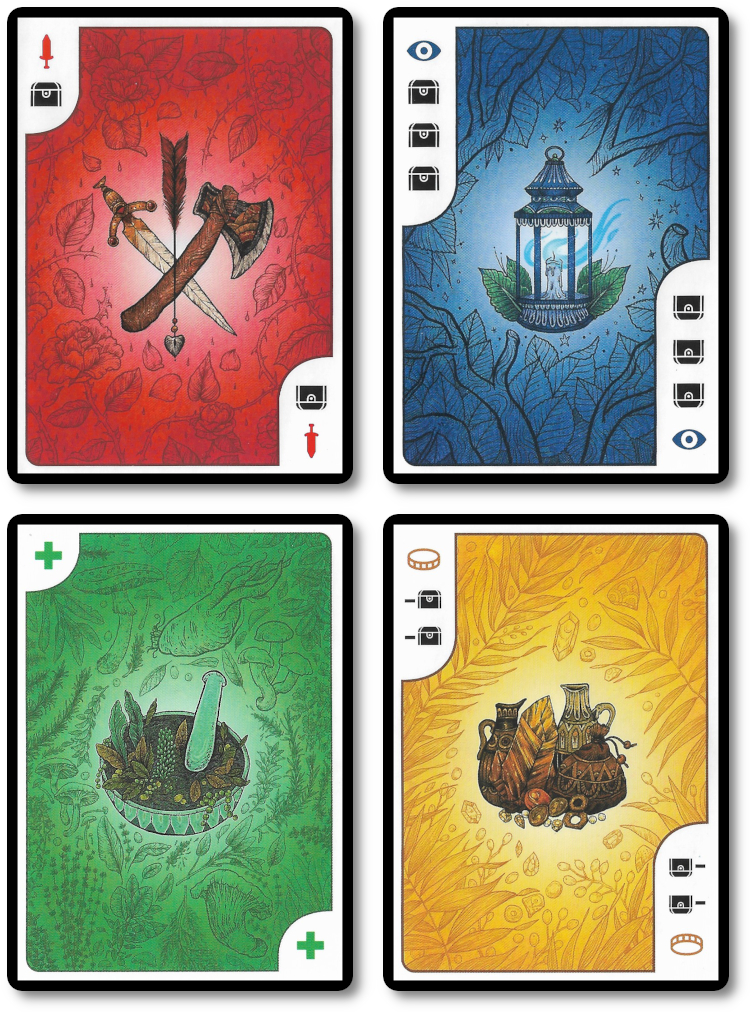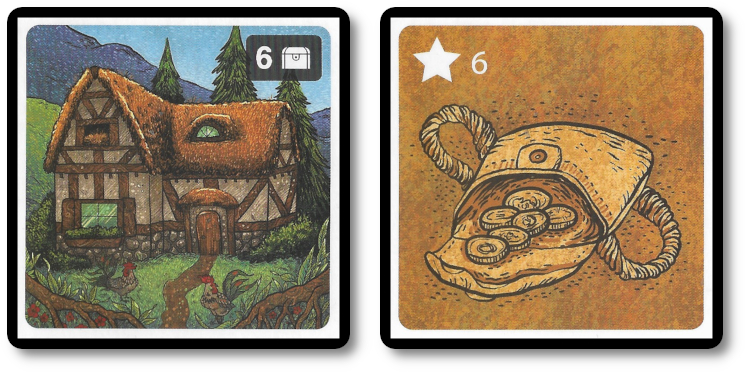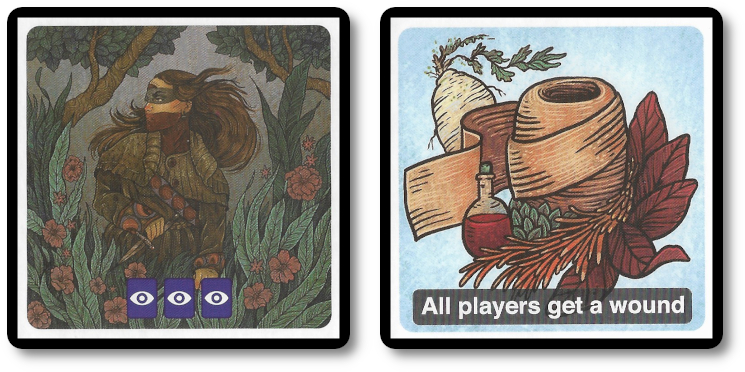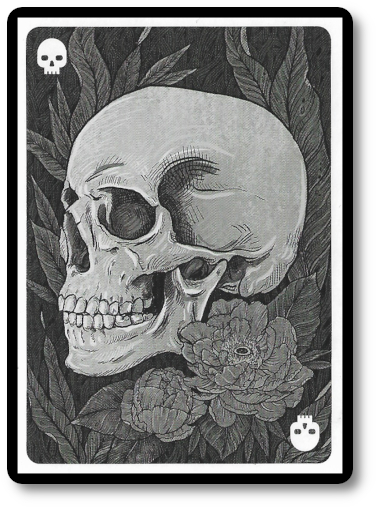 The Basics:
The Basics:
- For ages 8 and up
- For 2 to 5 players
- Approximately 30 minutes to complete
Geek Skills:
- Active Listening & Communication
- Counting & Math
- Logical & Critical Decision Making
- Reading
- Strategy & Tactics
- Risk vs. Reward
- Cooperative & Team Play
- Hand/Resource Management
- Bluffing and Misdirection
Learning Curve:
- Child – Easy
- Adult – Easy
Theme & Narrative:
- Help build a town or secretly work to ensure its ruin
Endorsements:
- Gamer Geek approved!
- Parent Geek approved!
- Child Geek approved!
Overview
American architect, who has been called a “father of skyscrapers” and “father of modernism,” Louis Sullivan said, “What the people are within, the buildings express without.” In this game, everyone at the table is outwardly working to build a beautiful new town for you to live in. Inside, however, they might not be what they seem. To your right might be those who work to ensure the town prospers or fails. Do you take the hard path and work towards building a new home for all, or secretly hoard your wealth to survive? The choice is yours, but the outcome is up to everyone.
Dawn, designed by Taylor Hayward and published Green Meadow Games, is comprised of 144 Resource cards, 20 Wound cards, 23 Building tiles, 17 Threat tiles, and four Great Building cards. The card quality is outstanding. Each card is highly durable and includes beautiful artwork by Angela Rizza.
So You Want to Build a New Home?
Complete the following steps to set up the game.
First, shuffle the Resource cards. There is a word of caution here for anyone playing the game right out of the box for the first time. You are going to need to shuffle these cards. Once the cards are shuffled, place face-down the entire pile in the middle of the playing area. This is the Resource draw deck for the duration of the game. Leave room for a discard pile.
Second, shuffle the Building tiles and return a set number to the game box based on the number of players. The remaining Building tiles still in play should be placed face-down next to the Resource draw deck. This is the Building draw deck for the duration of the game. Deal to each player at this time seven Resource cards. These cards go into the player’s hand.
Third, deal to each player two Wound cards. These cards also go into the player’s hand. Place any remaining Wound cards next to the Resource deck.
Fourth, place the four Great Building cards in a row in the middle of the playing area and within easy reach of all the players. Make sure the Great Building cards are face-up.
This completes the game setup. Determine who will go first and begin.
To Build a Town
Dawn is played in turns and rounds for six rounds per game. Dawn is a game of hidden agendas and semi-cooperative gameplay, wherein players can decide to either work towards a common goal (referred to as an “Ally”) and build the town or secretly work to hoard riches (referred to as a “Scoundrel”) and work to undermine progress out of greed. Both approaches are valid, and the objective of each player is uniquely their own, determined by their own strategy and playing style.
At the start of the first five rounds, several Building tiles are dealt and put into play by placing them in a row, face-down. The number of Building tiles placed is based on the number of players in the game. Placing Building tiles in a row is skipped during the sixth and final round, wherein only the Great Building cards are available to the players.
Afterward, each player will select one card from their hand and place it face-down in their Storehouse. The “Storehouse” is a specially designated area in front of the player. The card is placed down secretly and will remain face-down for the game’s duration until the end. The card selected is important, as it will determine the player’s affiliation (“Ally” or “Scoundrel”). Players who want to be Scoundrals should play “Treasure” Resource cards. Any other Resource card played indicates you are an Ally.
Once the Building tiles are in play (or just the Great Building cards), each player will take a turn in the round. A player’s turn is summarized here.
Step One: Take Actions
There are several actions available to the player on their turn. The player may take as many actions as they like and in any order, including repeating the same action multiple times. The actions are as follows:
Swap Cards
This action allows the player to take one Resource card from their Storehouse and swap it with any single Resource card in their hand. Why? Players may realize their current standing as an Ally or a Scoundrel may have been a mistake and want to improve their chances of winning the game.
Contribute to a Building or a Threat
This action allows the player to play as many Resouce cards as they like, from their hand face-down to a Building tile, a Great Building card, or a Threat tile. Cards played to Building tiles, and Threats will be resolved at the end of the round. All cards played to the Great Building cards are resolved at the end of the game.
When placing cards, the Resource type matters. Note that the “Wild” Resource card can represent any of the other three Resource card types.
- “Attack” Resource cards (red color, sword symbol)
- “Heal” Resource cards (green color, cross symbol)
- “Spy” Resource cards (blue color, eye symbol)
- “Wild” Resource cards (yellow color, coin symbol)

Great Building cards are the type and number of Resource cards needed to complete the build.
Heal Wounds
This action allows the player to remove one Wound card from their hand or any other player’s hand by discarding three “Heal” Resource cards. When doing so, reveal the three “Heal” Resource cards and place them in the Resource card discard pile. Then point to the player who will receive the benefit, having them discard one of the Wound cards in their hand back to the Wound card pile.
Raid a Great Building
This action allows the player to look at two random cards currently under a Great Building card by discarding one “Attack” Resource card. When doing so, reveal the “Attack” Resource card and place it in the Resource card discard pile. Then pick two cards randomly from any of the Great Building cards and secretly look at them. The player may then remove one of the two cards from the game, placing it in the box without any other player seeing it.
Spy on a Building or Threat
This action allows the player to look at any face-down Building or Threat tile by discarding one “Spy” Resource card. When doing so, reveal the “Spy” Resource card and place it in the Resource discard pile. Then look at a Building or Threat tile, ensuring no other player sees it. This informs the player what to expect when the card is revealed.


Discard
This action allows the player to discard any number of Resource cards in their hand to the Resource discard pile.
Step Two: Pass
After the player has completed all the actions they want to take or cannot take any additional actions, they announce they are passing. By doing so, the player has completed their turn for the round, and the next player in the turn order sequence now takes their turn.
Ending the Round
After all the players have passed, the round comes to an end. It’s time to see how the players’ little town is progressing.
Determine Buildings
Shuffle all the Resource cards under each of the Building tiles. This is done to ensure that no one can identify what cards were played by the other players. Then reveal all the Resource cards contributed to each Building tile one at a time, adding up the total value of the Treasure. If the total is equal to or greater than the required Treasure for the building card, the Building is completed and placed next to the Great Building cards with its Resource cards but remains face-down.
If, however, the total Treasure is less than what is required, it’s discarded without revealing its face. This includes any Building tiles that have no Resource cards currently attached. Discard any Resource cards, as well.
Deal with Threats
Shuffle all the Resource cards under the Threat tile. Then reveal all the Resource cards contributed to each Threat tile, determining if the number and type of Resource required by the Threat tile has been provided. If the requirements have been met, discard the Threat tile and the attached Resource cards.
If the Threat tile requirements have not been met, flip over the Threat card and resolve its negative impact. This could include destroying a Building tile, inflicting Wound cards, or possibly nothing. Then discard the Threat tile and any attached Resource cards.
Draw Cards
Lastly, all players are now dealt Resource cards to refill their hand to nine cards. Note that Wound cards count as part of the player’s hand. This means the more wounds the player has, the fewer Resource cards they have available. A player will need to heal these wounds during their turn using a “Heal” Resource card or a mix of “Wild” and “Heal” Resource cards.

This completes the round. A new round begins with the second player during the previous round becoming the first player in the next round.
Ending the Game
After the sixth round, the game ends, and it’s time to determine the winner.
First, all players reveal their affiliation. This is done by all players now showing what cards are in their Storehouse. The total Treasure value of the Resource cards is calculated. A player with more than seven is considered a “Scoundrel.” Anything less than seven means the player is an “Ally.” more than one player may be a Scoundrel. Count on it and play accordingly.
Second, determine if the Great Buildings were constructed. This is done by revealing all the Resource cards and then determining if the requirements for the Great Building card have been met. The amount of success is awarded or taken away based on whether the Great Building is completed.

Finally, determine if the town was successfully founded by adding up the total number of Prosperity points off all the completed Building cards (including Great Buildings). If the total number equals or exceeds 30 points per Ally player, the Ally players win the game! If the total is less than 30 points, the Scoundrals win, but not all of them. The Scoundral with the highest amount of Treasure in their personal Storehouse walks away with the victory.
Game Variant
Three to five players are required to play the basic game. Two players can also play Dawn with the provided rules already summarized here and then by randomly playing a small number of cards out to the table. This simulates the choices that would have been made by other players throughout the game.
To learn more about Dawn, visit the game’s web page.
Final Word
 The Child Geeks very quickly learned how to play Dawn and did very well from the first card to the last. The game is easy to understand – and with cards working in multiple ways – players are never left without options. What caused most of our Child Geeks to frown, however, was the game’s victory condition. According to one Child Geek, “I like how you can switch sides whenever you like, but I think it’s very hard to win the game unless you are greedy.” Another Child Geek said, “I liked the game a lot. I especially liked how I could decide to be a good guy and help the village or be a bad guy and steal all the treasure whenever I wanted to!” Ultimately, the Child Geeks put aside their dislike of losing and focused on the joy of playing, finding Dawn a real winner.
The Child Geeks very quickly learned how to play Dawn and did very well from the first card to the last. The game is easy to understand – and with cards working in multiple ways – players are never left without options. What caused most of our Child Geeks to frown, however, was the game’s victory condition. According to one Child Geek, “I like how you can switch sides whenever you like, but I think it’s very hard to win the game unless you are greedy.” Another Child Geek said, “I liked the game a lot. I especially liked how I could decide to be a good guy and help the village or be a bad guy and steal all the treasure whenever I wanted to!” Ultimately, the Child Geeks put aside their dislike of losing and focused on the joy of playing, finding Dawn a real winner.
 The Parent Geeks approached Dawn like a semi-cooperative right from the start. They enjoyed themselves up until they started to realize that allegiances in the game were not only invisible but in flux. According to one Parent Geek, “I very much enjoyed the game, found the gameplay to be clever, and the choices to be made always empowering and important. What I found interesting, however, is how the game invites players to pick and choose their sides as often as they like. I could focus on the town in the first round, not like what I see, and decide to save my skin in the next round. This made each round of the game interesting and challenged me to think of what I wanted to be the outcome at the end, too.” Another Parent Geek said, “Great game. Loved it. The card plays are smart, and the end of the game was always a delightful surprise. Even when I lost, I had a blast. I will play this game repeatedly if given the opportunity.” When the final house was built, the Parent Geeks evaluated their work and found Dawn worth keeping around.
The Parent Geeks approached Dawn like a semi-cooperative right from the start. They enjoyed themselves up until they started to realize that allegiances in the game were not only invisible but in flux. According to one Parent Geek, “I very much enjoyed the game, found the gameplay to be clever, and the choices to be made always empowering and important. What I found interesting, however, is how the game invites players to pick and choose their sides as often as they like. I could focus on the town in the first round, not like what I see, and decide to save my skin in the next round. This made each round of the game interesting and challenged me to think of what I wanted to be the outcome at the end, too.” Another Parent Geek said, “Great game. Loved it. The card plays are smart, and the end of the game was always a delightful surprise. Even when I lost, I had a blast. I will play this game repeatedly if given the opportunity.” When the final house was built, the Parent Geeks evaluated their work and found Dawn worth keeping around.
 The Gamer Geeks, as they do, were significantly more creative and sarcastic about their sarcasm. They hit this game hard, looking for ways to break it and find faults. They tried. They tried and failed. They did find a game that awards forward-thinking and strategic gameplay and punishes wishy-washy behavior. One Gamer Geek said, “This was a tough game to understand. Not because the rules are difficult or the gameplay ambiguous. Rather, I was confused about what the game wanted me to do. Should I be a Scoundral? An Ally? Both? Neither? I kept looking for the game to inform me. All it did was just look at me with a smirk, giving me the strong impression it was smarter than me. Guess what? It was.” Another Gamer Geek said, “Not light and not heavy, the game comes across as slightly bland at first. The first rounds were no problem, and I thought I had the game in the bag until the score was counted. Holy crap, did I read the table wrong! In the second game, I paid much more attention to the players and the table talk. What a different game! Enjoyed myself.” When dusk had settled on the little town, the Gamer Geeks all agreed their time was well spent at the gaming table playing Dawn.
The Gamer Geeks, as they do, were significantly more creative and sarcastic about their sarcasm. They hit this game hard, looking for ways to break it and find faults. They tried. They tried and failed. They did find a game that awards forward-thinking and strategic gameplay and punishes wishy-washy behavior. One Gamer Geek said, “This was a tough game to understand. Not because the rules are difficult or the gameplay ambiguous. Rather, I was confused about what the game wanted me to do. Should I be a Scoundral? An Ally? Both? Neither? I kept looking for the game to inform me. All it did was just look at me with a smirk, giving me the strong impression it was smarter than me. Guess what? It was.” Another Gamer Geek said, “Not light and not heavy, the game comes across as slightly bland at first. The first rounds were no problem, and I thought I had the game in the bag until the score was counted. Holy crap, did I read the table wrong! In the second game, I paid much more attention to the players and the table talk. What a different game! Enjoyed myself.” When dusk had settled on the little town, the Gamer Geeks all agreed their time was well spent at the gaming table playing Dawn.
 Full disclosure, this game was hard to get to the table. Summertime is not a great time to review games with friends and family when all said friends and family are off on trips. I also moved, lost the game in the moving boxes, found the game, and lost access to friends due to Summer vacations. When we finally did get the game to the table, everyone was getting after me for not putting this game on the table sooner. From the start, it was clear that Dawn would be a winner. Which, in an exciting twist, made the game hard to get off the table.
Full disclosure, this game was hard to get to the table. Summertime is not a great time to review games with friends and family when all said friends and family are off on trips. I also moved, lost the game in the moving boxes, found the game, and lost access to friends due to Summer vacations. When we finally did get the game to the table, everyone was getting after me for not putting this game on the table sooner. From the start, it was clear that Dawn would be a winner. Which, in an exciting twist, made the game hard to get off the table.
And a winner it truly is. The gameplay has many familiar elements but uses them uniquely, making the game feel fresh. The number of choices in the game will initially feel overwhelming, but all players quickly realize you are only ever genuinely interested in a handful based on your objectives. However, this should not suggest choices are ever limited. Each game asks the players the same questions. How the players answer those questions changes every round, thus making every turn a unique experience.
A word of caution for players who think it wise to switch alliances throughout the game continually. Don’t. While the game does give the player freedom to change sides during their turn, each round is different. Players can undoubtedly influence the outcome of each round, but never to a point beyond what cards they have available. This is where table talk is essential to the game. Ensure you banter, barter, tell tales, lie, and persuade as much as possible. Suppose you get others to play cards that help you and your goals; all the better. This would lead many to think that playing as the Scoundral is the smart move until you realize that only one Scoundral wins the game, not all of them. Competition among thieves is fierce!
Do play Dawn when the opportunity presents itself. It’s a fun game, full of twists and turns, and best of all, an outcome that no one sees coming until the very end. A great game to wake up to!
This game was given to Father Geek as a review copy. Father Geek was not paid, bribed, wined, dined, or threatened in vain hopes of influencing this review. Such is the statuesque and legendary integrity of Father Geek.




Insightful review! The review of ‘Dawn’ provides a comprehensive understanding of the game, allowing readers to grasp its features, gameplay, and overall experience. Evaluating the graphics, storyline, and mechanics gives prospective players valuable insights before diving into the game. Reviews like this are incredibly helpful in guiding gaming enthusiasts towards making informed decisions on choosing their next gaming adventure. Thanks for providing this insightful review of ‘Dawn’!